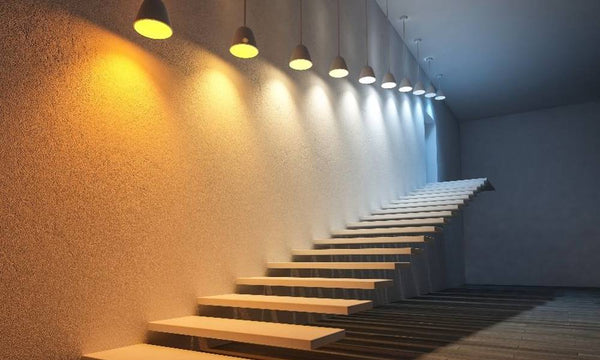Picup your order for free
Provide a more affordable shopping experience

Circadian lighting and human-centric lighting solutions have become prevalent, yet many integrators may lack a comprehensive understanding of their functionality and the optimal scenarios for recommending them to clients.
Exploring Circadian Lighting
For those delving into the realm of lighting, the term "circadian lighting" may have crossed their path, prompting questions about its essence. While a product emphasizing the imitation of natural lighting likely falls under the circadian lighting category, this explanation only scratches the surface.
In this discussion, we will delve into the intricacies of circadian lighting, exploring the reasons behind its rising prominence, its impact on human health, and ways to integrate these systems into businesses or personal spaces.
Decoding Circadian Lighting
The term "circadian" in circadian lighting refers to the circadian rhythm, the biological clock governing the human body's sleep and wake cycles. This rhythm operates on a 24-hour cycle aligned with the natural day and night sequence.
Despite the substantial time span between humans residing under open skies and the present day, our bodies have not evolved new mechanisms for regulating sleep-wake cycles. The body still relies on cues from the surrounding light to discern the time.
Circadian lighting, at its core, endeavors to leverage the adaptable properties of LEDs to replicate the natural progression of sunlight throughout the day. Its nomenclature reflects its aim: assisting building occupants in maintaining a natural sleep schedule in environments with limited natural light sources.
A proficient circadian lighting system establishes a robust daytime signal in the morning while diminishing it in the evening.
Understanding Correlated Color Temperature (CCT)

Color temperature, a crucial element in circadian lighting, pertains to how the eyes perceive various tones of white light, corresponding to sunlight hues at different times of the day.
Correlated color temperature (CCT) specifies the color wavelength emitted by a light, measured in degrees Kelvin (K). This metric, ranging from 1000K to 10000K, designates lower temperatures for warmer, redder lights and higher temperatures for cooler, bluer colors.
Impact of Modern Lighting on Circadian Rhythm
Considering an average light bulb with a fixed CCT, such as in an office set to 4,500K, can illustrate potential harm to circadian rhythms. While this color temperature stimulates alertness in daytime activities, the body lacks a reference point for slowing down in the evening.
The fixed color temperature can mislead the body into thinking it's morning even in the late evening, inhibiting melatonin production and disrupting the natural sleep-wake cycle. This issue extends beyond offices, with most individuals spending only about 10% of their day outdoors, depriving their bodies of natural lighting signals.
Poor sleep schedules resulting from inadequate lighting can lead to issues like fatigue, impacting metabolism and cortisol levels. Circadian lighting, when optimized for circadian health, has shown benefits in various settings, including offices, hospitals, nursing homes, and residential communities.
Correcting Sleep Schedules with Circadian Lighting
Circadian lighting addresses the gradual disruption caused by artificial lighting by focusing on entrainment—a stimulus delivered consistently at the right moment. While color temperature is a key aspect, circadian lighting considers various visual and non-visual stimuli for entrainment, including intensity, positioning, timing, and spectrum.
In circadian lighting, lower color temperatures represent early morning and late evening, while higher temperatures simulate daytime conditions. The system adjusts lights throughout the day within the average CCT range of sunlight, from 2700K to roughly 6500K.
Positioning is crucial, considering how light hits the melanopsin pigment in the lower part of the eye, delivering a robust waking signal to the brain. Night lights are often recommended below eye level to avoid triggering a melanopsic response.
Spectrum, another vital factor, involves ensuring that LED lights replicate the "sky-blue signal" at 490nm, the wavelength most sensitive to melanopsin.
Significance of Color Rendering Index (CRI) and TM-30-18
While color temperature is well-known in circadian lighting, spectrum is equally critical. Melanopsin is highly sensitive to 490nm light, the "sky-blue signal," often assessed through the Color Rendering Index (CRI). A CRI above 90 is desirable for circadian lighting.
However, advancements have led to the development of TM-30-18, aiming to replace CRI as a metric for color rendition. TM-30-18 evaluates a light's Fidelity Index (Rf), Gamut Index (Rg), and Color Vector Graphic, providing a more comprehensive assessment with 99 color evaluation samples.
Role of Lighting Controls in Circadian Lighting
Control is pivotal in circadian lighting, differentiating between average and exceptional systems. Automation is highly sought after, mirroring the seamless phases of the sun without constant manual intervention. Leading control manufacturers often include a default 'circadian schedule,' simplifying the integration of circadian-appropriate light fixtures.
Light sensors, such as Crestron's SolarSync, measure the color temperature and intensity of outdoor light, adjusting indoor lights accordingly. These devices contribute to the circadian system's responsiveness to natural lighting fluctuations, enabling decisions on artificial lighting adjustments based on natural light saturation.
Circadian lighting should complement, not replace, natural light in buildings. Integrating window treatments, such as shades that adjust to minimize solar glare during the day and block bright exterior lighting in the evening, plays a significant role in triggering circadian responses and enhancing visual comfort.
Circadian Lighting vs. Human-Centric Lighting
While these terms are often used interchangeably, circadian lighting and human-centric lighting have subtle distinctions. Circadian lighting specifically targets improving circadian rhythms through light entrainment. In contrast, human-centric lighting has a broader focus on utilizing light to enhance overall human performance, health, and wellbeing in a space.
In summary, circadian lighting, with its nuanced approach, proves instrumental in promoting occupant wellbeing across diverse environments. Its careful consideration of color temperature, spectrum, and automation sets the stage for a future where lighting is not just functional but deeply aligned with our natural biological rhythms.
Leave a comment